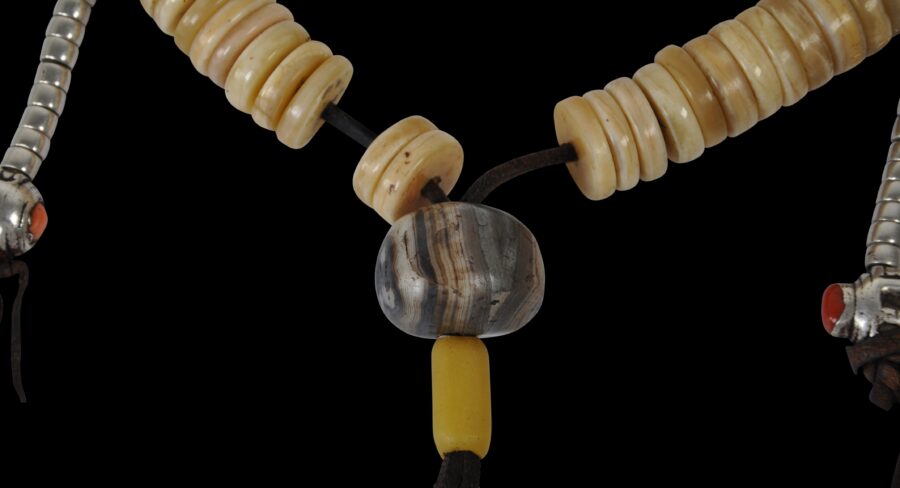This Tibetan Buddhist rosary (sin-‘phen), most probably of human bone in which case it is also known as a Mi Mgo’i Phreng Ba, has bone disks that are the largest we have seen. They are ample and the rosary is chunky and weighty on the hand. As such, the rosary was intended for a particularly senior Tibetan monk.
Human bone rosaries were used in respect for wrathful-deity rituals.
The patina from age and handling is splendid and incontrovertible, with each bone bead having a creamy, lustrous colour and some, an almost translucent nature.
It comprises 108 flattened, bone beads; a large banded agate bead serves as the central marker, beneath which there is an old, elongated yellow glass trade bead; and two sets of ten silver counter beads with silver vajra terminals inset with coral and turquoise.
Buddhist rosaries evolved from ancient Hindu-Indian mala prayer beads. In Tibet, they were used by both laymen and monks. Full sets comprise 108 beads (plus others as counters) – but not always. The numbers varied according to personal taste and also the types of ritual and deities the rosaries were to be used in respect of.
The main prayer beads were used to count repetitions of prayers and the counters were used to record multiples of the main beads, so that thousands of repetitions could be counted. Users typically held them in their left hands whilst chanting.
The set here is in a fine, stable condition. It is a superb and rare example.
It has come from an old, private London collection acquired over decades.
References
Daalder, T., Ethnic Jewellery and Adornment: Australia, Oceania, Asia, Africa, Ethnic Art Press/Macmillan, 2009.
Henss, M., Buddhist Ritual Art of Tibet: A Handbook on Ceremonial Objects and Ritual Furnishings in the Tibetan Temple, Arnoldsche, 2020.
Reynolds, V., Tibet: A Lost World: The Newark Museum Collection of Tibetan Art and Ethnology, The American Federation of Arts, 1978.
Sherr Dubin, L., The Worldwide History of Beads, Thames & Hudson, 2009.








